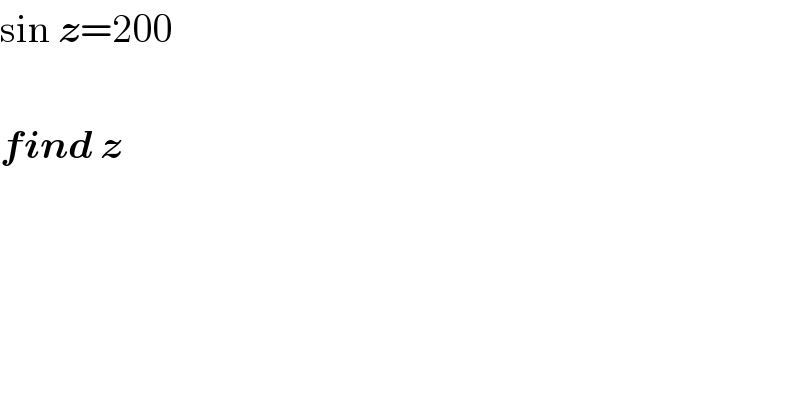
Question Number 19419 by NEC last updated on 10/Aug/17

$$\mathrm{sin}\:\boldsymbol{{z}}=\mathrm{200} \\ $$$$ \\ $$$$\boldsymbol{{find}}\:\boldsymbol{{z}} \\ $$
Commented by NEC last updated on 10/Aug/17

$${yes}.\:{i}\:{know}\:{that}. \\ $$$${if}\:{its}\:{a}\:{complex}\:{number}\:{i}'{ll}\:{like} \\ $$$${to}\:{see}\:{it}.{Thanks} \\ $$
Answered by sma3l2996 last updated on 10/Aug/17

$${sinz}=\frac{{e}^{{iz}} −{e}^{−{iz}} }{\mathrm{2}{i}}=\mathrm{200}\Leftrightarrow{e}^{{iz}} −{e}^{−{iz}} =\mathrm{400}{i}\:\:;\:{z}={a}+{ib} \\ $$$${e}^{{ia}} {e}^{−{b}} −{e}^{−{ia}} {e}^{{b}} =\mathrm{400}{i} \\ $$$${e}^{−{b}} \left({cosa}+{isin}\left({a}\right)\right)−{e}^{{b}} \left({cosa}−{isina}\right)=\mathrm{400}{i} \\ $$$${cos}\left({a}\right)\left({e}^{−{b}} −{e}^{{b}} \right)+{isin}\left({a}\right)\left({e}^{−{b}} +{e}^{{b}} \right)=\mathrm{400}{i} \\ $$$${cos}\left({a}\right)=\mathrm{0}\: \\ $$$${sin}\left({a}\right)\left({e}^{−{b}} +{e}^{{b}} \right)=\mathrm{400} \\ $$$${a}=\frac{\pi}{\mathrm{2}}+{k}\pi \\ $$$$\left(−\mathrm{1}\right)^{{k}} \left({e}^{−{b}} +{e}^{{b}} \right)=\mathrm{400} \\ $$$${e}^{\mathrm{2}{b}} +\mathrm{1}=\left(−\mathrm{1}\right)^{{k}} \mathrm{400}{e}^{{b}} \\ $$$${e}^{\mathrm{2}{b}} +\left(−\mathrm{1}\right)^{{k}+\mathrm{1}} \mathrm{400}{e}^{{b}} +\mathrm{1}=\mathrm{0} \\ $$$${e}^{\mathrm{2}{b}} +\left(−\mathrm{1}\right)^{{k}+\mathrm{1}} \mathrm{2}×\mathrm{200}{e}^{{b}} +\mathrm{200}^{\mathrm{2}} −\mathrm{200}^{\mathrm{2}} +\mathrm{1}=\mathrm{0} \\ $$$$\left({e}^{{b}} +\left(−\mathrm{1}\right)^{{k}+\mathrm{1}} \mathrm{200}\right)^{\mathrm{2}} =\mathrm{4}×\mathrm{10}^{\mathrm{4}} −\mathrm{1} \\ $$$${e}^{{b}} =\sqrt{\mathrm{39999}}+\left(−\mathrm{1}\right)^{{k}} \mathrm{200} \\ $$$${b}={ln}\left(\sqrt{\mathrm{39999}}+\left(−\mathrm{1}\right)^{{k}} \mathrm{200}\right) \\ $$
Commented by NEC last updated on 11/Aug/17

$${wow}!\:{thanks} \\ $$$$ \\ $$$${how}\:{is}\:{a}=\frac{\pi}{\mathrm{2}}+{k}\pi\:\:\:\:? \\ $$
Commented by sma3l2996 last updated on 11/Aug/17

$${because}\:{cos}\left({a}\right)=\mathrm{0} \\ $$
Commented by NEC last updated on 11/Aug/17

$${thanks}....\:{its}\:{understood}. \\ $$
